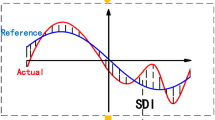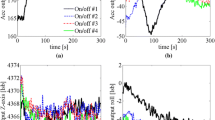Abstract
To achieve the goal of low-cost MEMS gyros for the precise self-localization of mobile robots, this paper presents a simple, yet effective method to minimize drifts on the heading angle by combining measurements from a gyro with measurements from wheel encoders (odometry). The main idea of the proposed approach is to estimate the accuracy of both sensors as a function of the actual maneuver being carried out, and then the output of both sensors are fused by the complementary filter taking into account the maneuvering conditions. The proposed method is applied to a mobile robot and the experimental data demonstrate the effectiveness of this approach.
Similar content being viewed by others
References
S. Y. Kim, K. S. Yoon, D. H. Lee, and M. H. Lee, “The localization of a mobile robot using a pseudolite ultrasonic system,” International Journal of Control, Automation, and Systems, vol. 9, no. 2, pp. 339–347, 2011.
J. Borenstein and L. Feng, “Measurement and correction of systematic odometry errors in mobile robots,” IEEE Trans. on Robotics and Automation, vol. 1, no. 6, pp. 869–880, December 1996.
J. Borenstein and L. Feng, “Gyrodometry: a new method for combining data from gyros and odometry in mobile robots,” Proc. of the IEEE International Conf. on Robotics and Automation, Minneapolis, pp. 423–428, April 1996.
M. D. Cecco, “Sensor fusion of inertial-odometric navigation as a function of the actual maneuvers of autonomous guided vehicles,” Institute of Physics Publishing, Meas. Sci. Technol., vol. 14, no. 5, pp. 643–653, 2003.
J. M. Kim, Y. T. Kim, and S. S. Kim, “Indoor localization for mobile robot using extended Kalman filter,” Journal of Fuzzy Logic and Intelligent Systems, vol. 18, no. 5, pp. 706–711, 2008.
S. K. Hong, S. Moon, and Y. Ryuh, “Angle measurements for mobile robots with filtering of shortterm noise in inertial sensors,” Trans. of the Institute of Measurement & Control, vol. 33, no. 6, pp. 650–664, 2011.
S. K. Hong and S. Park, “Minimum-drift heading measurement using a MEMS gyro for indoor mobile robots,” Sensors Journal, vol. 8, no. 11, pp. 7287–7299, November 2008.
J. Bae and S. K. Hong, “Improvement of heading error using a wavelet de-noising filter for indoor mobile robots: application to MEMS Gyro,” Journal of Institute of Control, Robotics and Systems (Korean), vol. 14, no. 9, pp. 893–897, August 2008.
S. K. Hong, “Fuzzy logic based performance augmentation of MEMS Gyroscope,” Journal of Intelligent & Fuzzy System, vol. 19, no. 6, pp. 393–398, Feb. 2007.
S. K. Hong, “Fuzzy logic based closed-loop strapdown attitude system for UAV (Unmanned Aerial Vehicle),” Sensors and Actuators A-Physical, vol. 107, no. 1, pp. 109–118, October 2003.
Author information
Authors and Affiliations
Corresponding author
Additional information
Recommended by Editor Hyun Seok Yang.
This research was supported by the National Research Foundation of Korea (NRF) funded by the Ministry of Education, Science and Technology (2011-0016807).
Sung Kyung Hong received his B.S. and M.S. degrees in Mechanical Engineering from Yonsei University, Korea, in 1987 and 1989, and his Ph.D. degree from Texas A&M University, U.S.A. in 1998. From 1989 to 2000, he was with the UAV System Div. of the Agency for Defense Development (ADD) in Korea. He has been a professor of the Department of Aerospace Engineering of Sejong University, Korea, since 2000. His research interests include autonomous system designs.
Sang Cheol Lee received his B.S. degree in Aerospace Engineering from Sejong University in 2012. He is currently doing a masters course in Aerospace Engineering at Sejong University. His research interests include guidance and navigation, and navigation sensors.
Jae Won Han received his B.S. and M.S. degrees in Aerospace Engineering from Sejong University, Korea, in 2008 and 2010, respectively. He is currently an Engineer at the Korea Institute of Industrial Technology. His research interests include unmanned system controls.
Young-sun Ryuh received his B.S., M.S. and Ph.D. degrees in Biosystem Engineering (Robotics) from Seoul National University, Korea, in 1984, 1986 and 1997, respectively. From 1991 to 2000, he worked at the SJMC research center as a director, and from 2000 to 2003 was a CEO of Roboland Co., Ltd. Since 2000, he has been a director of the Biomimetic Robot Research Group and Marine Robot Center of Korea Institute of Industrial Technology. His research interests include Biomimetic Robotics and rehabilitation.
Rights and permissions
About this article
Cite this article
Hong, S.K., Leev, S.C., Han, J.W. et al. Minimal-drift heading measurement using a MEMS gyro for mobile robots: Fused with odometry. Int. J. Control Autom. Syst. 10, 1000–1004 (2012). https://doi.org/10.1007/s12555-012-0517-z
Received:
Accepted:
Published:
Issue Date:
DOI: https://doi.org/10.1007/s12555-012-0517-z




